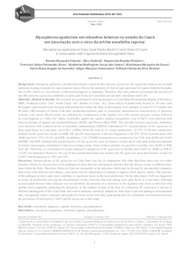Mycoplasma agalactiae em rebanhos leiteiros no estado do Ceará em associação com o vírus da artrite encefalite caprina.
Mycoplasma agalactiae em rebanhos leiteiros no estado do Ceará em associação com o vírus da artrite encefalite caprina.
Autoria: PEIXOTO, R. M.; ANDRIOLI, A.; PINHEIRO, R. R.; ALVES, F. S. F.; SANTOS, V. W. S. dos; SOUSA, M. M. de; AZEVEDO, D. A. A. de; DAMASCENO, E. M.; TEIXEIRA, M. F. da S.
Resumo: Background: Contagious agalactia is an infectious disease caused by Mycoplasma agalactiae (M. agalactiae) that occurs in small ruminants leading to productive and economic losses. Due to the similarity of clinical signs presented in Caprine Arthritis Encephalitis (CAE), which is a viral disease, a differential diagnosis is important. Therefore, this study aimed to investigate the presence of anti-Mycoplasma agalactiae antibodies in dairy goat flocks in Ceará State and possible correlation with CAE. Materials, Methods & Results: The research was performed in four mesoregions in Ceará State (Metropolitan Region of FortalezaMRF; Northeast Ceará - NeC; North Ceará - NC; Sertões in Ceará - SC), from which 16 productions located in 10 cities with the highest representativeness for goat milk production within the State or mesoregion were sampled. A total of 417 females and 69 males (486 animals) of breeds with dairy production aptitude, pure or crossbreed, maintained in semi-intensive or intensive systems, were tested. Blood serum was obtained by venipuncture of the jugular vein with vacuum pressure syringe followed by centrifugation at 1,500 g for 10min. Antibodies against the caprine arthritis encephalitis virus (CAEV) were detected with micro technique of agarose gel immunodiffusion (AGID) and Western Blot (WB). The anti-Mycoplasma agalactiae antibodies were detected with commercial kit of enzymatic immunoassay (IDEXX Laboratories). Seroprevalence of M. agalactiae in dairy goat flocks in Ceará State was 0.62% (3/486). From the total of 16 visited productions, 18.75% (3/16) had seropositive animals for M. agalactiae located in MRF, NC and SC mesoregions. CAE was diagnosed in 56.25% (9/16) of productions with AGID and in 81.25% (13/16) with WB. In addition, 5.2% (25/486) of animals were seropositive for CAE with AGID and 16.6% (80/486) with WB. Animals that reacted positive for M. agalactiae were all females of pure breed with milk production aptitude in distinct mesoregions submitted to intensive rearing system. None of these animals was positive in neither test (AGID or WB) for CAE. Therefore, no correlation of results obtained in diagnosis of M. agalactiae by ELISA and CAEV by AGID or WB (P < 0.05) was identified. However, two out of three productions that were positive for M. agalactiae presented positive results for CAEV with frequencies of 10% and 20%. Discussion: Seroprevalence of M. agalactiae in Ceará State was low in comparison with other Brazilian states and even other countries. However, the presence of the pathogen in more than one mesoregion indicates that the disease occurs in different locations within the State. Therefore, flocks in Ceará are susceptible to the infection, which may be favored by uncontrolled commerce that occurs with deficient surveillance, associated with the importation of animals to improve flock genetic quality. The presence of the pathogen in dairy goats may contribute to significant losses in the local production. On the other hand, CAE was diagnosed in nearly all productions proving the dissemination of this lentivirus infection among dairy goat flocks in Ceará State. Although an association between these diseases was not identified, the presence of a retrovirus in the organism may favor co-infection with another micro-organism, promoting the deficiency in the immune system of the host. In conclusion, M. agalactiae is present in different mesoregions of the Ceará State and control measures should be adopted in short term to prevent pathogen dissemination and, consequently reduce economic and productive losses in the local dairy goat production. No correlation was identified between the prevalence of infection by CAEV and M. agalactiae in this study. [Mycoplasma agalactiae in dairy goat flocks bred in Ceará State of Ceará in association with Caprine Arthritis Encephalitis Virus].
Ano de publicação: 2018
Tipo de publicação: Artigo de periódico
Unidade: Embrapa Caprinos e Ovinos
Palavras-chave: Agalaxia contagiosa, Anticorpo, CAE, CAEV, Caprine arthritis encephalit virus, Caprino, Correlação, Diagnosis, Diagnóstico, Doença animal, Micoplasmose, Mycoplasmoses
Observações
1 - Por padrão são exibidas publicações dos últimos 20 anos. Para encontrar publicações mais antigas, configure o filtro ano de publicação, colocando o ano a partir do qual você deseja encontrar publicações. O filtro está na coluna da esquerda na busca acima.
2 - Para ler algumas publicações da Embrapa (apenas as que estão em formato ePub), é necessário ter, no celular ou computador, um desses softwares gratuitos. Sistemas Android: Google Play Livros; IOS: iBooks; Windows e Linux: software Calibre.
Acesse outras publicações
Acesse a Base de Dados da Pesquisa Agropecuária (BDPA) para consultar o acervo completo das bibliotecas da Embrapa.

